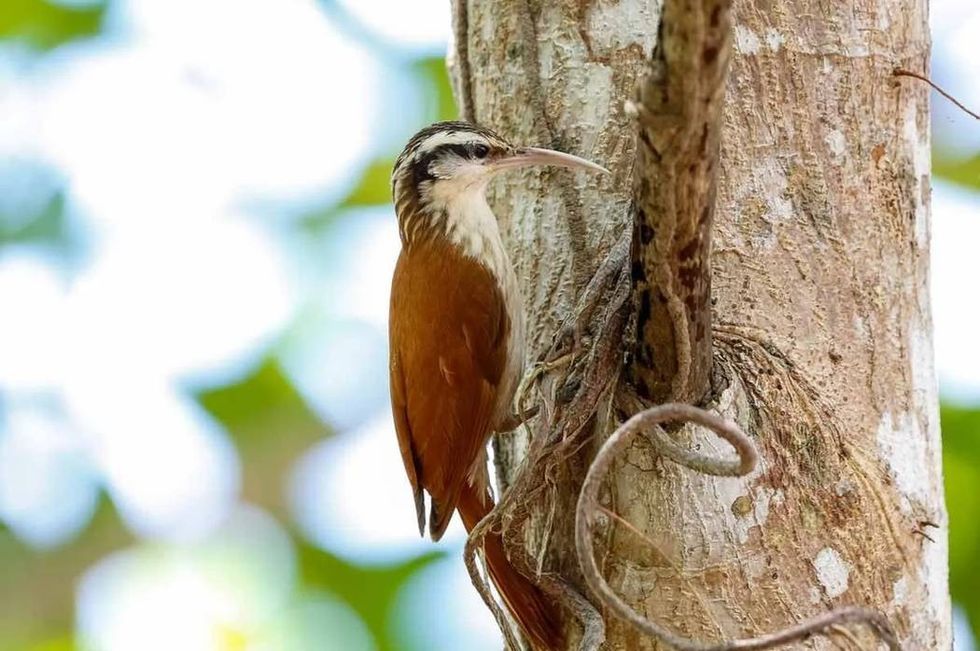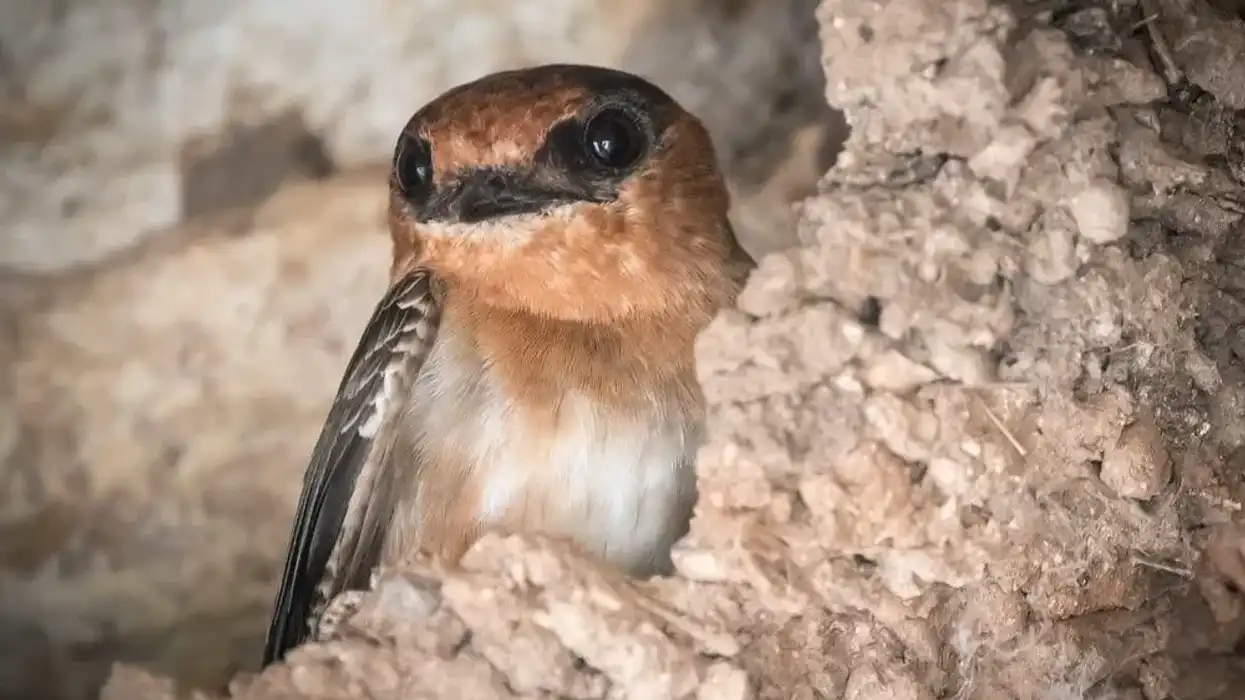There are a total of 50 subspecies in the family Dendrocolaptidae, woodcreepers. There exist several genera in this species namely certhiasomus, deconychura, sittasomus, dendrocincilla like the plain brown woodcreeper (Dendrocincla fuliginosa), glyphorynchus, naisica, dendrexetastes, dendrocolaptes, hylexetastes, xiphocolaptes, dendroplex, woodcreeper xiphorhynchus flavigaster, campylorhamphus, drymotoxeres, drymornis, and Lepidocolaptes.
They are small to medium-sized birds and although they belong to the same family they have differences in appearance and in look.
These species are more popularly seen in parts of southern Mexico to northern Brazil. They belong to Furnariidae and the sub-family Dendrocolaptidae woodcreepers. These birds may in various instances be confused with woodpeckers however they differ both in color and pattern.
While woodpeckers have distinct colors and patterns woodcreepers are largely the same color i.e. brown to red, brown to yellow, brown to olive color. Woodcreepers are more easily identified by their sound.
If you like this article then visit Eastern towhee and hummingbird facts.
Woodcreeper Interesting Facts
What type of animal is a woodcreeper?
Woodcreeper is a species of bird and is popularly seen in parts of southern Mexico to northern Brazil.
What class of animal does a woodcreeper belong to?
Woodcreepers belong are a type of bird that belong to the Aves class of species and they belong to Furnariidae and subfamily Dendrocolaptidae woodcreepers.
How many woodcreepers are there in the world?
The exact number of woodcreepers in the world is not determined in exact figures however there exist a total of 50 subspecies of woodcreeper species. To list a few there exists the ivory-billed woodcreeper seen in Central America, great rufous woodcreeper native to South America, billed woodcreeper xiphorhynchus, and woodcreeper dendrocincla among others.
Where does a woodcreeper live?
Woodcreepers live in lowland tropical forests specifically on the bark of trees in the woods. They are also seen in semi-open habitats, savannas, and arid scrubs and are endemic to neotropics. They are spotted below 1000 m range elevations. Some of the species can also be spotted in urban to suburban areas but this is a rare occasion.
What is a woodcreeper's habitat?
They are largely neotropical birds and live in various types of habitats but they are specifically seen in and around forest regions and on the bark of trees. There are multiple types of woodcreepers and each one is native to different regions.
The highest woodcreepers occur in the lowlands of the Amazon Basin where different types of woodcreepers are seen. They do not migrate anywhere.
Who do woodcreepers live with?
They are monogamous birds and move with their mate and are also seen frequently traveling with mixed species of feeding flocks including jays and orioles. They specifically join flocks that include other bird species while looking for food. Such birds uniquely employ such strategies to save themselves from possible predators.
How long does a woodcreeper live?
Woodcreepers are species that excavate their own nest cavities and are known as primary cavity nesters. Their average lifespan in the wild is from two to five years in age. Their life expectancy depends on various factors like their diet and environment as well.
How do they reproduce?
Woodcreepers live in male-female pairs all year long different from other species of birds. These pairs are monogamous in nature and participate in all phases of reproductive activity.
Some species of woodcreepers are known to be polygynous as well. They breed all year round however some of the species choose seasonal breeding.
They nest in cavities and most of these nests are usually five meters off the ground. Post mating the female lays two to three eggs and the incubation period lasts 14-16 days. They develop through various stages during these weeks the young ones are born without feathers and are completely dependant on their parents for food and others requirements.
The parents feed their offspring insects, spiders, grasshoppers as well as small lizards. They are found in family groups in most instances.
What is their conservation status?
The Woodcreeper (Dendrocolaptinae) status is not evaluated by the International Union For Conservation Of Nature (IUCN).
Woodcreeper Fun Facts
What do woodcreepers look like?
Most woodcreepers have a similar outer appearance and have slight differences in appearance. Woodcreepers range from 5.5-14 in which is 14-36 cm in length.
They have an overall body of brown but there are slightly more color and pattern variations that can be identified if observed closely. They have a fine pale streaking on the head and back which is easily confused with larger ivory shades. They have brownish underparts and brown and white streaker head and throat as well.
Both males and females have similar external anatomy and coloration. Their tail feathers are broad and stiff in stout and finally, the most distinguishing feature on them is their bill which they utilize to find possible prey.

How cute are they?
They are unique and beautiful species of birds and cute to look at given their size is mostly small to medium-sized. These types of birds are seldom seen by humans unless they come into urban or semiurban areas. Woodcreepers cause no harm to humans.
How do they communicate?
They make use of songs as well as calls to communicate and do so mostly during dusk and dawn. Their songs are not at all musical in nature.
They have a series of ascending and descending musical notes which they use when they accompany mixed-species foraging flocks. The song is a trill-like series of notes some repeatedly utter harsh or sad notes and others trill. During mating season they have a series of calls to communicate to possible mates
How big is a woodcreeper?
Woodcreeper is 5.5-14 in (14-36 cm) in length which is 10 times bigger than the smallest bird in the world the bee hummingbird which is 2.4 in (6.1 cm) tall.
How fast can a woodcreeper fly?
The Woodcreeper moves fast however when they land on a bark they usually creep up trees using their tail as a brace. These birds are territorial beings and may fight if their territory is meddled with.
How much does a woodcreeper weigh?
A Woodcreeper on average weighs 0.14 lb (64 g). Different types of woodcreepers weigh slightly different but they are more or less the same. The heaviest bird is known as the ostrich and it is also the tallest bird species.
What are their male and female names of the species?
The male and female species are not addressed differently.
What would you call a baby woodcreeper?
The baby woodcreeper can be referred to as a nestling when young. Once they develop wings and are able to find prey for themselves they become fully functioning adults and are become completely independent. Both parents are equally involved in raising the young.
What do they eat?
They primarily feed on small vertebrates like ants, lizards, and frogs. They also feed on crabs and snails, grasshoppers, crickets, beetles, cockroaches as well as spiders. On rare occasions, woodcreepers are known to feed on fruits and seeds as well but this only happens if they don't find anything in sight.
Are they dangerous?
They are not innately dangerous birds and are not harmful towards humans. They are wild birds and hence they are hosts to a number of blood parasites and feather lice. They primarily feed on insects and have a powerful beak to attack their prey. Their color helps them camouflage into nature saving them from possible predators.
Would they make a good pet?
They are innately wild beings hence they are not adopted as pets and thrive best in the wild. Woodcreepers have different environmental needs and need a proper environment to survive. Exceeding felling of trees is leading to loss of habitat for these species in turn affecting other animal species who depend on them as their primary source of diet.
Did you know...
Not all species of woodcreepers are considered Not Evaluated. Some species of the same family like the ivory billed woodcreeper are considered Critically Endangered almost to the point of the ivory billed woodcreeper being considered a lost species.
How can you tell apart male and female woodcreeper birds?
Both males and females have similar external anatomy and coloration hence it becomes difficult to identify the difference between the two, however, there is one way to identify the same and this is by identifying their size males tend to be larger as compared to female species.
There exist minor differences in male and female woodcreeper species in different members of the family. For example, the plain brown woodcreeper Dendrocincla fuliginosa male has short wings and the female has long wings.
Similarly, other species of woodcreepers in the same family have slight differences in appearances.
How many eggs do woodcreepers lay?
Post mating the female lays two to three eggs and the incubation period lasts 14-16 days. The eggs are white and have no particular marks on them.
These eggs are laid in nests made of bark chips, wooden shavings, plants, and leaf material. Woodcreeper pairs are monogamous and in some instances polygynous in nature. These species of birds are often confused with the woodpecker species however they are completely different.
If you wish to see these unique and beautiful species, visit a region native to these birds and try to identify the particular genus of the woodcreeper family you came across. You could make use of online applications to assist you with identifying the particular species you came across.
Here at Kidadl, we have carefully created lots of interesting family-friendly animal facts for everyone to discover! Learn more about some other birds including the pileated woodpecker or eastern kingbird.
You can even occupy yourself at home by drawing one on our woodcreeper bird coloring pages.










